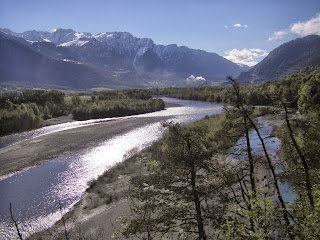First things first: I very much warmed to the photos in this tome, especiallly because of the fantastic light, and particularly the light of the colour pics on the Julierpass. I felt slightly less enchanted about the foggy ones of the Gotthardpass and wondered whether they were probably meant as illustrations for a Sherlock Holmes movie.
Quite some of the pics (the ones of the Säntis, for instance) radiate an aura of impending drama, I also experienced sensations of awe and respect when meditating on the majestic nature of the Swiss Alps. I did however fail to see what connected these impressive pictures with the music of Richard Wagner.
This is how Antoine Wagner sees it: "The images selected for this book testify, how the scenery of his work often reminds one of the vistas he discovered on his hikes; most of the time alone. In my opinion it is impossible not to feel how this light, these clouds, this special atmosphere have influenced the setting for his myths and Gods."
Brunnen 2013 @ Antoine Wagner
It would be of course easy to criticise this photographic project for it goes without saying that Antoine Wagner cannot know what Richard Wagner saw and felt. In other words, these photographs can only show what Antoine Wagner wants us to look at, they probably have not much to do with what Richard Wagner experienced. On the other hand, there is indeed a special light and atmosphere in the Alps and that surely hasn't changed since Richard Wagner's days. That even includes things at the Faulhorn: "The rooms have stayed the same, so they say: no water, no heat; with a sore back, weak legs and bloody feet, only the 'schnapps' can warm you up."
I decided to put my scepticism aside and to give in to the sensations that these images evoke. And, I can confirm what Antoine Wagner states: "The contemplation of such desolate landscapes triggers introspection, a thirst for learning more about nature, almost an urge for searching to discover the essence of mankind."
Faulhorn 2013 @ Antoine Wagner
The photos in this work are the result of "a six-week journey, by foot, train and boat, starting at Lake Constance. After crossing glaciers, frozen lakes and fierce peaks", Antoine Wagner finally found his way to Zurich. These images are an invitation to imagine what Richard Wagner might have felt when in the Swiss Alps. I thought it to be an inspirational invitation.
Antoine Wagner
Wagner in der Schweiz
(Deutsch, English, Français)
Verlag für Moderne Kunst, Nürnberg 2013






























